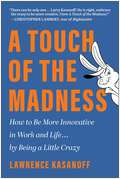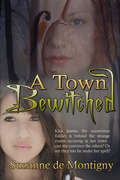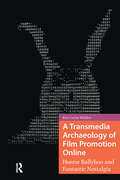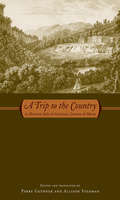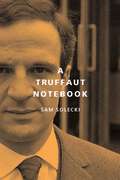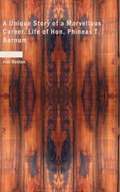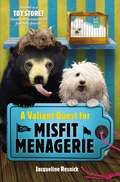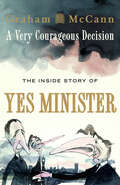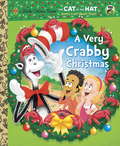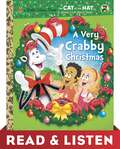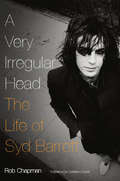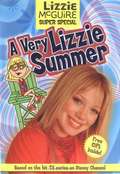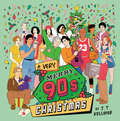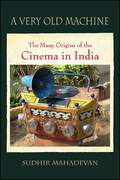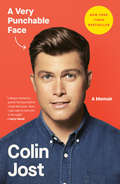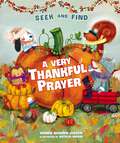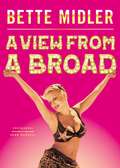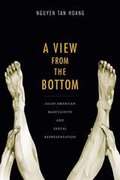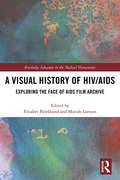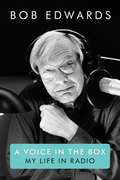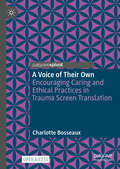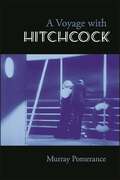- Table View
- List View
A Touch of the Madness: How to Be More Innovative in Work and Life . . . by Being a Little Crazy
by Lawrence KasanoffLegendary movie producer Larry Kasanoff knows firsthand that massive success requires taking big risks—it paid off for him with blockbusters Terminator 2: Judgment Day and Dirty Dancing, and other feature films. Now, he&’s sharing behind-the-scenes stories and hard-won wisdom to help creatives thrive in any industry. Larry will be the first to tell you that excelling in any creative field requires taking big risks. It means embracing your crazy side: the most unique, boldest, and bravest part of you, and your greatest asset when it comes to creating something truly original. In A Touch of the Madness, Larry uses firsthand memories from working on some of Hollywood&’s biggest blockbusters, including Terminator 2: Judgment Day, Platoon, True Lies, Dirty Dancing, and the Mortal Kombat film series, to show you the three principles that form the foundation of a thriving career in any industry: Create a great idea that will excite your audience Ask as many times (and as many people) as it takes to get a &“yes&” Play while you work—don&’t forget to have fun Companies and organizations tend to be comfortable with the tried and true. But customers are attracted to what&’s new, different, and better. To be innovative, you have to be a little crazy. A Touch of the Madness will help you embrace your wildest creative impulses and live your dreams—without anyone holding you back.
A Town Bewitched
by Suzanne De MontignyIt’s tough for Kira, growing up in the small town of Hope as a child prodigy in classical violin, especially when her dad just died. And to make matters worse, Kate McDonough, the red-haired fiddler appears out of nowhere, bewitching the town with her mysterious Celtic music. Even Uncle Jack succumbs to her charms, forgetting his promise to look after Kira’s family. But when someone begins vandalizing the town leaving dead and gutted birds as a calling card, Kira knows without a doubt who’s behind it. Will anyone believe her?
A Transmedia Archaeology of Film Promotion Online: Horror Ballyhoo and Fantastic Nostalgia (Transmedia)
by Kim WaldenAt a time when more films are released annually than there are days in the year, films must compete for audience attention. As a result, promotional budgets have risen exponentially with online becoming the fastest growing sector. Film websites don’t just promote films, they chronicle backstories, map storyworlds, introduce characters and provide spaces for audiences to congregate. Yet as a hybrid of promotion, storytelling and community hub, these sites are ephemeral, and when the promotional work is done, they are often locked, taken down and disappear without trace. This book considers this emerging form: Where have film websites been collected and archived? What forms do these websites take? And how do audiences engage with film websites? Drawing on media archaeological methods as well as developing new strategies to investigate these intriguing media objects, this book suggests that film websites are worthy of consideration as cultural artefacts in their own right.|In Beyond the Screen (2014), Sarah Atkinson describes film sites as ‘new filmic objects’ and an ‘unparalleled cultural form’. This book makes these ‘new filmic objects’ its focus and sets out to discover more about them. The Producers Guild of America’s definition of transmedia practices extends to ‘narrative commercial and marketing roll outs’, so one way these ‘new filmic objects’ can be understood is as a kind of transmedia marketing. However, while there is no shortage of how-to manuals on transmedia storytelling and transmedia marketing, these practices remain under-theorised in the literature. So, this is what this book sets out to do.
A Trip to the Country: by Henriette-Julie de Castelnau, Comtesse de Murat
by Perry Gethner Allison Stedman Henriette-Julie de Castelnau Comtesse De MuratTranslates an important example of late seventeenth-century French hybrid experimental fiction that provided the primary literary backdrop for the first French fairy tales.
A Truffaut Notebook
by Sam SoleckiFrançois Truffaut (1932-1984) ranks among the greatest film directors and has had a worldwide impact on filmmaking as a screenwriter, producer, film critic, and founding member of the French New Wave. His most celebrated films include The 400 Blows, Shoot the Piano Player, Jules and Jim, Day for Night, and The Last Metro. A Truffaut Notebook is a lively and eclectic introduction to the life and work of this major cinematic figure. In entries as brief as a page, as well as in full-length essays, it examines topics such as Truffaut's mentors, the autobiographical nature of his films, his place in the film tradition, his film criticism, his reputation, his relationships with other directors, and the formal and thematic coherence of his body of work. Sam Solecki also argues for Truffaut's continuing appeal and relevance by examining his influence on filmmakers like Woody Allen, Noah Baumbach, Alexander Payne, Patrice Leconte, and Jean-Pierre Jeunet, and on writers such as Julian Barnes, Ann Beattie, and Salman Rushdie. Because the book returns regularly to the author's shifting responses to Truffaut's work over the last fifty years, it also offers an autobiographical meditation on his own lifelong fascination with film. Consisting of over eighty short entries and essays, as well as provocative lists, dreams, and quizzes, A Truffaut Notebook is an original and exciting text and a model of passionate engagement with cinema.
A Truffaut Notebook (McGill-Queen's Studies in Urban Governance #3)
by Sam SoleckiAn unconventional and deeply engaging introduction to a major figure in modern film.
A Unicorn in a World of Donkeys: A Guide to Life for All the Exceptional, Excellent Misfits Out There
by Mia MichaelsAn empowerment manifesto for creatives, misfits, innovators, and disruptors from the star of So You Think You Can Dance and creator of Broadway's Finding NeverlandA Unicorn in a World of Donkeys offers a playbook for living a creative and authentic life. Using her own story as a launching spot, and creative quizzes, charts, and lists to engage the reader in an interactive journey, Mia Michaels explores the experience of the unicorn in a world of donkeys, a world where fitting in, pleasing others, following rules, and maintaining norms-no matter how messed up those norms are-is the only acceptable path. She acknowledges the struggles of the unicorn life-loneliness, ridicule, being misunderstood and undervalued-and goes on encourage readers to reframe the unicorn life the way she has, as essential to a life of brilliance.
A Unique Story of a Marvellous Career: Life of Hon. Phineas T. Barnum
by Joel BentonThere is none that stands for more notable success in his chosen line none that recalls more memories of wholesome entertainment none that is more invested with the fragrance of kindliness and true humanity.
A Valiant Quest for the Misfit Menagerie
by Jacqueline ResnickTrapped in a toy store? Sounds like a mission for four furry friends. Bertie, Susan, and the Misfit Menagerie--Smalls the sun bear, Rigby the Komondor dog, and Wombat the wombat--have at long last escaped from evil Grand Master Claude's Most Magnificent Circus and are finally free to live life at their leisure. But there's something missing. Something that's keeping them from moving on. Or rather, someone. Tilda the Angora rabbit--and fourth member of the Misfit Menagerie--is being held captive at Toddle's Toy Emporium, a massive toy store more impressive than even F.A.O. Schwarz. Now Bertie, Smalls, and the gang--including a sword-wielding hedgehog--must embark on a quest to rescue their kidnapped friend, braving the mean streets of Hollyhoo City and the bratty Chrysantheum Toddle. It's a journey that will take them over an actual clay rainbow, force them to hide among stuffed animals in a life-like jungle, and lead them to soar above the ground in a hot-air balloon--all big tasks for animals who only recently saw that there was a world outside of Mr. Mumford's farm. But if they're valiant enough, they just might reunite the menagerie and find themselves a new home.
A Very Courageous Decision: The Inside Story of Yes Minister
by Graham McCannA behind-the-scenes history of one of the most successful and admired British sitcoms of the 1980s.In 1977 the BBC commissioned a new satirical sitcom set in Whitehall. Production of its first series was stalled, however, by the death throes of Jim Callaghan’s Labour government and the ‘Winter of Discontent’; Auntie being unwilling to broadcast such an overtly political comedy until after the general election of 1979.That Yes Minister should have been delayed by the very events that helped bring Margaret Thatcher to power is, perhaps, fitting. Over three series from 1980—and two more as Yes, Prime Minister until 1988—the show mercilessly lampooned the vanity, self-interest and incompetence of our so-called public servants, making its hapless minister Jim Hacker and his scheming Permanent Secretary Sir Humphrey two of the most memorable characters British comedy has ever produced. The new prime minister professed it her favourite television programme—a ‘textbook’ on the State in inaction—and millions of British viewers agreed. In the years since Yes Minister has become a national treasure: Sir Humphrey’s slippery circumlocutions have entered the lexicon, regularly quoted by political commentators, and the series’ cynical vision of government seems as credible now as it did thirty years ago.Much of this success can be credited to its writers, Antony Jay and Jonathan Lynn, who drew on their contacts in Westminster to rework genuine political folly as situation comedy. Storylines that seemed absurd to the public were often rooted in actual events—so much so that they occasionally attracted the scrutiny of Whitehall mandarins. In A Very Courageous Decision acclaimed entertainment historian Graham McCann goes in search of the real political fiascos that inspired Yes Minister. Drawing on fresh interviews with cast, crew, politicians and admirers, he reveals how a subversive satire captured the mood of its time to become one of the most cherished sitcoms of Thatcher’s Britain.
A Very Crabby Christmas (Little Golden Book)
by Dave Aikins Tish RabeThe Cat in the Hat has just received a special invitation! He and Sally and Nick have been invited to Mervin the Crab's Crab Christmas Ball on Christmas Island. But soon after the Thinga-ma-jigger lands on the island, chaos ensues when Crab Nine (aka Sandy) goes missing. Is Sandy lost or injured? Will the ball go on as planned? Only readers of the book will find out! Loosly adapted from the one-hour prime-time PBS Kids special--The Cat in the Hat Knows a Lot About Christmas!--this $3.99 Little Golden Book arrives just in time for the holidays and makes a perfect gift.
A Very Crabby Christmas (Little Golden Book)
by Tish RabeRead and listen along with the Cat in the Hat as he and the gang visit Christmas Island to attend Mervin the Crab's Crab Christmas Ball! But soon after the Thinga-ma-jigger lands on the island, chaos ensues when Crab Nine (aka Sandy) goes missing. Is Sandy lost or injured? Will the ball go on as planned? Only readers of the book will find out! Loosely adapted from the one-hour prime-time PBS Kids' holiday special—The Cat in the Hat Knows a Lot About Christmas!—this ebook with Read & Listen audio narration arrives just in time for the holidays and makes a perfect gift. This ebook includes Read & Listen audio narration.
A Very Irregular Head: The Life of Syd Barrett
by Rob ChapmanSyd Barrett was the lead guitarist, vocalist, and principle songwriter in the original line up of Pink Floyd. During his brief time with the band (1966-68) he was the driving force behind the unit. After he left the band he made just two further solo albums which were both released in 1970, before withdrawing from public view to lead a quiet, and occasionally troubled life in Cambridge, the town of his birth. Rob Chapman's book will be the first authoritative and exhaustively researched biography of Syd Barrett that fully celebrates his life and legacy as a musician, lyricist and artist, and which highlights the influence that he continues to have over contemporary bands and music fans alike.
A Very Lizzie Summer
by Lisa PapademetriouA Very Lizzie Summer (Lizzie McGuire Super Special): Get ready to jump into summer with this super-sized, totally original Lizzie McGuire junior novel! It's summertime and the living is sweet. Er, well, it's going to be if Lizzie finishes at the top of her junior lifeguard class. Then she'll get to assist that hottie head lifeguard at the Hillridge Community Pool for the rest of the summer. There's only one snag-Queen of Mean Kate Sanders wants the top spot too. Hello! Can you say sabotage? Will Lizzie get sunk or will she get a summer job near a hunk? Meanwhile, Lizzie's best friend, Miranda, starts crushin' on an Internet chat pal. And her other bestie, Gordo, gets an extremely disturbing extreme makeover. Get psyched for a sizzling summer with Lizzie!
A Very Merry 90s Christmas
by J. T. KelliherCelebrate this holiday season with all your favorite 90s stars, icons, and pop-culture moments!'Twas the night before Christmas when all through the house the only sound you could hear was the click of a mouse… This illustrated gift book is a perfect stocking stuffer for anyone who wants to relive the best decade of the twentieth century.
A Very Merry Dunder Mifflin Christmas: Celebrating the Holidays with The Office
by Christine KopaczewskiCelebrate the holidays the Dunder Mifflin way with this official, one-of-a-kind Christmas-spectacular handbook filled with recipes, tips, and pranks inspired by one of the most popular comedy series of all time. <P><P>Season's Greetings from Scranton, Pennsylvania, and your favorite group of Dunder Mifflin misfits. Over the course of seven iconic Christmas episodes, The Office delighted audiences everywhere with unconventional and seriously funny memories. Each December, ready to blow off a year's worth of pent-up boredom and frustration, the hyped-up holiday party was the ultimate escape from the team's monotonous paper-pushing gigs and the perfect recipe for chaos, love triangles, and prank wars to ensue -- and they did. <P><P>In A Very Merry Dunder Mifflin Christmas, relive your favorite festive moments -- like when Andy gifted Erin the twelve days of Christmas -- get tips on planning your own seasonal soiree like Angela and Phyllis, host the holidays like the Schrutes, prank your friends like Jim, Pam, and Dwight, and settle in for a round of Yankee Swap. This official licensed guide is an epic look back at all the ways Michael and his workmates at Dunder Mifflin made the most of their holiday seasons.
A Very Old Machine: The Many Origins of the Cinema in India (SUNY series, Horizons of Cinema)
by Sudhir MahadevanIn A Very Old Machine, Sudhir Mahadevan shows how Indian cinema's many origins in the technologies and practices of the nineteenth century continue to play a vital and broad function in its twenty-first-century present. He proposes that there has never been a singular cinema in India; rather, Indian cinema has been a multifaceted phenomenon that was (and is) understood, experienced, and present in everyday life in myriad ways. Employing methods of media archaeology, close textual analysis, archival research, and cultural theory, Mahadevan digs into the history of photography, print media, practices of piracy and showmanship, and contemporary everyday imaginations of the cinema to offer an understanding of how the cinema came to be such a dominant force of culture in India. The result is an open-ended and innovative account of Indian cinema's "many origins."
A Very Punchable Face: A Memoir
by Colin JostIf there’s one trait that makes someone well suited to comedy, it’s being able to take a punch—metaphorically and, occasionally, physically. <p><p> From growing up in a family of firefighters on Staten Island to commuting three hours a day to high school and “seeing the sights” (like watching a Russian woman throw a stroller off the back of a ferry), to attending Harvard while Facebook was created, Jost shares how he has navigated the world like a slightly smarter Forrest Gump. <p> You’ll also discover things about Jost that will surprise and confuse you, like how Jimmy Buffett saved his life, how Czech teenagers attacked him with potato salad, how an insect laid eggs inside his legs, and how he competed in a twenty-five-man match at WrestleMania (and almost won). You'll go behind the scenes at SNL and Weekend Update (where he's written some of the most memorable sketches and jokes of the past fifteen years). And you’ll experience the life of a touring stand-up comedian—from performing in rural college cafeterias at noon to opening for Dave Chappelle at Radio City Music Hall. <p> For every accomplishment (hosting the Emmys), there is a setback (hosting the Emmys). And for every absurd moment (watching paramedics give CPR to a raccoon), there is an honest, emotional one (recounting his mother’s experience on the scene of the Twin Towers’ collapse on 9/11). Told with a healthy dose of self-deprecation, A Very Punchable Face reveals the brilliant mind behind some of the dumbest sketches on television, and lays bare the heart and humor of a hardworking guy—with a face you can’t help but want to punch. <p> <b>A New York Times Bestseller</b>
A Very Thankful Prayer Seek and Find: A Fall Poem of Blessings and Gratitude (A Time to Pray)
by Bonnie Rickner JensenThis sweet fall-themed seek-and-find activity board book helps your preschooler grow in gratitude as they search, match, learn, and give thanks.This refreshed favorite makes a great gift for many special occasions for you and your children or grandchildren to enjoy throughout the fall season. Help your toddlers and preschoolers develop pre-reading skills while your family gives thanks for all that the season has to offer--from watching the autumn leaves fall and picking pumpkins from the patch to sharing a Thanksgiving meal with loved ones and learning how to give and receive.This interactive edition of A Very Thankful Prayer includesheartfelt rhyming text about all the blessings of the fall seasonwhimsical illustrations featuring woodland animals, updated to have just the right level of complexity for the youngest searchersa key of hidden objects on each page that includes the name of each itema bonus key on the back cover with even more items to find throughout the bookChildren ages 3 to 5 will build early learning skills as theydevelop observation and concentration skillslearn letter recognition and connect letters with their soundsidentify simple sight words and match words to picturesfind bright pumpkins, colorful leaves, cozy hats, adorable critters, and much morebuild confidence in their own value and skillsLook for other Bonnie Rickner Jensen titles in the Time to Pray series:A Very Merry Christmas PrayerA Very Merry Christmas Prayer Seek and FindA Very Happy Easter Prayer
A View from A Broad
by Bette MidlerBette Midler, also known as Divine Miss M--the indomitable and incomparable singer, actor, and musical theater extraordinaire, with a career spanning almost half a century--revisits her classic memoir, now with a new introduction.This book was a kind of last hurrah. When I read it, I hear a disarmingly younger, sweeter voice...I am not sure that this little confection captures a whole time, but I think it's an accurate picture of the spirit and tone of what I was doing in those days...I hope it holds up, and that you find your best younger self in it as I do... With her brassy voice and bold performances making the world finally pay attention, this ambitious Jewish girl from Hawaii, needs no introduction. Grammy award-winning singer, Academy Award-nominee, Broadway star of her critically acclaimed one-woman show, and beloved actress in The Rose, Beaches, and Down and Out in Beverly Hills--Bette Midler is a household name whose career and fans span generations. In A View from A Broad, Bette relives her career through memories of endless rehearsals, her fear of flying, crazy schedules, and wisdom she learned from Thai Gondoliers with her trademark razor-blade wit that her fans have grown to know, love, and expect. Filled with photographs, a new introduction, and heartwarming stories that highlight only a portion of a brilliant career, A View from a Broad is the perfect gift for anyone who loves music, theater, or just plain fun--and will be cherished by the fans of Divine Miss M for years to come.
A View from the Bottom: Asian American Masculinity and Sexual Representation
by Tan Hoang NguyenA View from the Bottom offers a major critical reassessment of male effeminacy and its racialization in visual culture. Examining portrayals of Asian and Asian American men in Hollywood cinema, European art film, gay pornography, and experimental documentary, Nguyen Tan Hoang explores the cultural meanings that accrue to sexual positions. He shows how cultural fantasies around the position of the sexual "bottom" overdetermine and refract the meanings of race, gender, sexuality, and nationality in American culture in ways that both enable and constrain Asian masculinity. Challenging the association of bottoming with passivity and abjection, Nguyen suggests ways of thinking about the bottom position that afford agency and pleasure. A more capacious conception of bottomhood--as a sexual position, a social alliance, an affective bond, and an aesthetic form--has the potential to destabilize sexual, gender, and racial norms, suggesting an ethical mode of relation organized not around dominance and mastery but around the risk of vulnerability and shame. Thus reconceived, bottomhood as a critical category creates new possibilities for arousal, receptiveness, and recognition, and offers a new framework for analyzing sexual representations in cinema as well as understanding their relation to oppositional political projects.
A Visual History of HIV/AIDS: Exploring The Face of AIDS film archive (Routledge Advances in the Medical Humanities)
by Elisabet Björklund Mariah LarssonThe Face of AIDS film archive at Karolinska Institutet, Sweden, consists of more than 700 hours of unedited and edited footage, shot over a period of more than thirty years and all over the world by filmmaker and journalist Staffan Hildebrand. The material documents the HIV/AIDS pandemic and includes scenes from conferences and rallies, and interviews with activists, physicians, people with the infection, and researchers. It represents a global historical development from the early years of the AIDS crisis to a situation in which it is possible to live a normal life with the HIV virus. This volume brings together a range of academic perspectives – from media and film studies, medical history, gender studies, history, and cultural studies – to bear on the archive, shedding light on memories, discourses, trauma, and activism. Using a medical humanities framework, the editors explore the influence of historical representations of HIV/AIDS and stigma in a world where antiretroviral treatment has fundamentally altered the conditions under which many people diagnosed with HIV live. Organized into four sections, this book begins by introducing the archive and its role, setting it in a global context. The first part looks at methodological, legal and ethical issues around archiving memories of the present which are then used to construct histories of the past; something that can be particularly controversial when dealing with a socially stigmatized epidemic such as HIV/AIDS. The second section is devoted to analyses of particular films from the archive, looking at the portrayal of people living with HIV/AIDS, the narrative of HIV as a chronic illness and the contemporary context of particular films. The third section looks at how stigma and trauma are negotiated in the material in the Face of AIDS film archive, discussing ideas about suffering and culpability. The final section contributes perspectives on and by the filmmaker as activist and auteur. This interdisciplinary collection is placed at the intersection of medical humanities, sexuality studies and film and media studies, continuing a tradition of studies on the cultural and social understandings of HIV/AIDS.
A Voice in the Box: My Life in Radio
by Bob EdwardsThe host of The Bob Edwards Show and Bob Edwards Weekend on Sirius XM Radio, Bob Edwards became the first radio personality with a large national audience to take his chances in the new field of satellite radio. The programs' mix of long-form interviews and news documentaries has won many prestigious awards. For thirty years, Louisville native Edwards was the voice of National Public Radio's daily newsmagazine programs, co-hosting All Things Considered before launching Morning Edition in 1979. These programs built NPR's national audience while also bringing Edwards to national prominence. In 2004, however, NPR announced that it would be finding a replacement for Edwards, inciting protests from tens of thousands of his fans and controversy among his listeners and fellow broadcasters. Today, Edwards continues to inform the American public with a voice known for its sincerity, intelligence, and wit. In A Voice in the Box: My Life in Radio, Edwards recounts his career as one of the most important figures in modern broadcasting. He describes his road to success on the radio waves, from his early days knocking on station doors during college and working for American Forces Korea Network to his work at NPR and induction into the National Radio Hall of Fame in 2004. Edwards tells the story of his exit from NPR and the launch of his new radio ventures on the XM Satellite Radio network. Throughout the book, his sharp observations about the people he interviewed and covered and the colleagues with whom he worked offer a window on forty years of American news and on the evolution of public journalism. A Voice in the Box is an insider's account of the world of American media and a fascinating, personal narrative from one of the most iconic personalities in radio history.
A Voice of Their Own: Encouraging Caring and Ethical Practices in Trauma Screen Translation
by Charlotte BosseauxThis open access book explores which audiovisual translation methods or techniques are the most ethical when translating personal narratives dealing with trauma and emotions, and provides good practice guidelines for different stakeholders (audiovisual translators, Language Service Providers, charities, survivors and filmmakers) to ensure that the voices of those who have suffered from trauma and Gender-Based Violence are ethically conveyed on-screen. It also shows how subtitlers cope with the translation of challenging sensitive material. The work described in this book is based on Prof Bosseaux&’s Ethical Translation project and is underpinned by a practical component: a multilingual documentary featuring women who have gone through traumatic events and whose first language is not English. Above all, the research emphasises the importance of filming and translating ethically with a focus on making sure survivors and audiovisual translators&’ voices are fully heard through respectful translation. This book showcases the theories and methods used and developed throughout the Ethical Translation project and the results of the research conducted, ultimately demonstrating the importance of carrying out practice-based research and encouraging collaboration between academics, practitioners and stakeholders to produce research that can be of use to, and be applied by, these groups.
A Voyage with Hitchcock
by Murray PomeranceFollowing from An Eye for Hitchcock and A Dream for Hitchcock, this third volume of reflections upon Alfred Hitchcock's work gives extensive meditations on six films: Psycho, The 39 Steps, The Birds, Dial M for Murder, Rich and Strange, and Suspicion. Murray Pomerance's sources come from a wide territory of interest, including production study, philosophy, cultural history, and more. The book is written as an homage to, and in many ways address to, not only the story content of these films but, more importantly, their overall filmic texture, which involves compositions, visual nuances, sounds, rhythms, and Hitchcock's unique treatments of human experience. The voyage theme plays a key—and moving—role in all the films discussed here.
